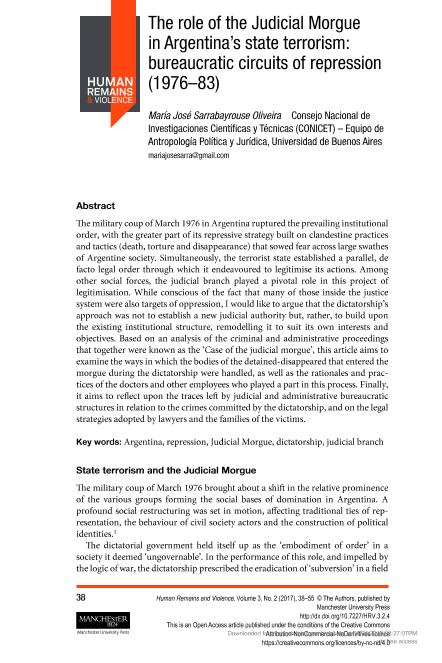Mostrar el registro sencillo del ítem
dc.contributor.author
Sarrabayrouse Oliveira, Maria Jose

dc.date.available
2019-04-24T20:29:44Z
dc.date.issued
2017-11
dc.identifier.citation
Sarrabayrouse Oliveira, Maria Jose; The role of the Judicial Morgue in Argentinas state terrorism: bureaucratic circuits of repression (1976-83); Manchester University Press; Human Remains and Violence; 3; 2; 11-2017; 38-55
dc.identifier.uri
http://hdl.handle.net/11336/74970
dc.description.abstract
Durante la última dictadura en la Argentina (1976-1983), la Morgue Judicial de la Ciudad de Buenos Aires fue utilizada por fuerzas militares como uno de los circuitos posibles para deshacerse de los cuerpos de los detenidos-desaparecidos. A partir del análisis de la causa judicial presentada en 1982 por el Centro de Estudios Legales y Sociales(CELS) conocida como la Causa de la Morgue Judicial, este artículo indagará tanto sobre el tratamiento que tuvieron los cadáveres de detenidos-desaparecidos que ingresaron irregularmente a la Morgue, como sobre las lógicas y prácticas de los médicos y empleados que intervinieron en este proceso. Finalmente, se buscará reflexionar sobre las huellas dejadas por las burocracias judiciales y administrativas con respecto a los crímenes cometidos por la dictadura y sobre las estrategias jurídicas desplegadas por abogados y familiares de las víctimas.
dc.description.abstract
The military coup of March 1976 in Argentina ruptured the prevailing institutional order, with the greater part of its repressive strategy built on clandestine practices and tactics (death, torture and disappearance) that sowed fear across large swathes of Argentine society. Simultaneously, the terrorist state established a parallel, de facto legal order through which it endeavoured to legitimise its actions. Among other social forces, the judicial branch played a pivotal role in this project of legitimisation. While conscious of the fact that many of those inside the justice system were also targets of oppression, I would like to argue that the dictatorship’s approach was not to establish a new judicial authority but, rather, to build upon the existing institutional structure, remodelling it to suit its own interests and objectives. Based on an analysis of the criminal and administrative proceedings that together were known as the ‘Case of the judicial morgue’, this article aims to examine the ways in which the bodies of the detained-disappeared that entered the morgue during the dictatorship were handled, as well as the rationales and practices of the doctors and other employees who played a part in this process. Finally, it aims to reflect upon the traces left by judicial and administrative bureaucratic structures in relation to the crimes committed by the dictatorship, and on the legal strategies adopted by lawyers and the families of the victims.
dc.format
application/pdf
dc.language.iso
eng
dc.publisher
Manchester University Press
dc.rights
info:eu-repo/semantics/openAccess
dc.rights.uri
https://creativecommons.org/licenses/by-nc-nd/2.5/ar/
dc.subject
Argentina
dc.subject
Represión
dc.subject
Morgue
dc.subject
Poder Judicial
dc.subject.classification
Otras Derecho

dc.subject.classification
Derecho

dc.subject.classification
CIENCIAS SOCIALES

dc.title
The role of the Judicial Morgue in Argentinas state terrorism: bureaucratic circuits of repression (1976-83)
dc.type
info:eu-repo/semantics/article
dc.type
info:ar-repo/semantics/artículo
dc.type
info:eu-repo/semantics/publishedVersion
dc.date.updated
2019-04-23T17:14:59Z
dc.identifier.eissn
2054-2240
dc.journal.volume
3
dc.journal.number
2
dc.journal.pagination
38-55
dc.journal.pais
Reino Unido

dc.journal.ciudad
Manchester
dc.description.fil
Fil: Sarrabayrouse Oliveira, Maria Jose. Consejo Nacional de Investigaciones Científicas y Técnicas; Argentina. Universidad de Buenos Aires. Facultad de Filosofía y Letras. Instituto de Ciencias Antropológicas. Sección de Antropología Social; Argentina
dc.journal.title
Human Remains and Violence
dc.relation.alternativeid
info:eu-repo/semantics/altIdentifier/url/https://www.manchesteropenhive.com/view/journals/hrv/3/2/article-p38.xml
dc.relation.alternativeid
info:eu-repo/semantics/altIdentifier/doi/https://doi.org/10.7227/HRV.3.2.4
Archivos asociados
